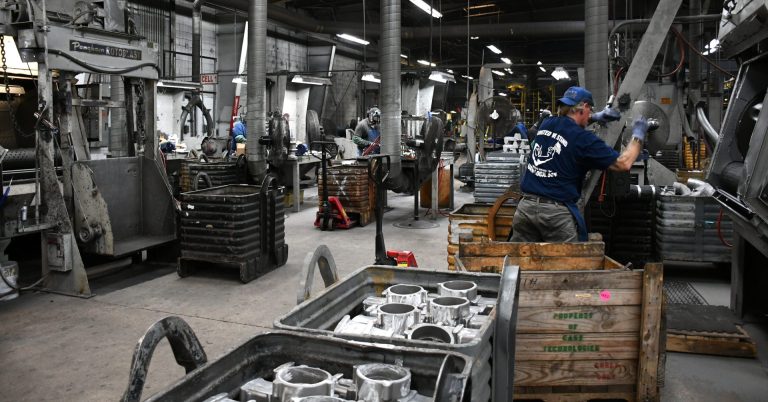About Aluminum Casting Chronicles: Methods, Trends, and Tips
Wiki Article
Opening the Prospective of Aluminum Spreading: Proven Techniques for Success
Light weight aluminum spreading has long been acknowledged for its convenience and widespread applications across numerous sectors. Join us as we explore the vital components that can propel aluminum casting towards unmatched success in today's competitive market landscape.Advantages of Aluminum Casting
Aluminum casting uses a wide range of advantages that make it a recommended choice in different industrial applications. One of the main benefits of aluminum casting is its lightweight nature, which adds to fuel performance in industries such as automobile and aerospace. Furthermore, light weight aluminum is extremely flexible, permitting intricate and detailed forms to be conveniently created through casting processes. This versatility in style is a considerable advantage for markets that need components with particular geometries.In addition, light weight aluminum casting gives superb deterioration resistance, making it optimal for applications where direct exposure to severe environments is a problem. The material additionally shows good thermal conductivity, which is helpful for sectors needing heat dissipation, such as electronics (about aluminum casting). Moreover, aluminum is totally recyclable, lining up with the growing focus on sustainable practices in modern-day production.
Style Considerations for Casting
The style stage plays a crucial function in the total success of an aluminum casting job. One vital consideration is the selection of suitable geometries and attributes that facilitate the spreading procedure.Additionally, considerations associated with parting lines, gating systems, and risers are important to avoid problems like porosity and shrinkage. It is important to maximize the layout for reliable product use and decrease post-processing needs. Simulations and prototyping can be beneficial tools in assessing and fine-tuning the casting design before full-blown manufacturing.
Cooperation in between design producers, foundries, and designers is essential to resolve any kind of possible difficulties early in the design phase. By including these factors to consider into the spreading layout procedure, producers can enhance item top quality, decrease costs, and inevitably open the full potential of light weight aluminum casting.
Enhancing Casting Efficiency
Creating with a concentrate on optimizing material flow and reducing problems is necessary when aiming to boost casting performance in aluminum spreading projects. To attain this, utilizing simulation software application can aid in identifying prospective concerns before the casting procedure starts. By mimicing the circulation of molten light weight aluminum, developers can adjust gating and riser styles to make certain proper filling and solidification, eventually minimizing the occurrence of problems such as porosity or contraction.
Furthermore, carrying out correct heat treatment processes can enhance the general spreading performance. Heat treatment can help enhance the mechanical residential or commercial properties of the light weight aluminum spreading, making certain that the final component meets the needed specs. Furthermore, using automation and robotics in the spreading procedure can simplify manufacturing, reduce manual work, and increase overall efficiency.
Additionally, constant tracking and high quality control throughout the spreading process are important for determining any type of variances and making sure that the end products fulfill the preferred criteria. By applying these approaches, suppliers can enhance casting effectiveness, improve product top quality, and inevitably attain higher success in aluminum spreading projects.
Quality Control in Light Weight Aluminum Spreading

Reliable top quality control techniques play an essential duty in making sure the accuracy and dependability of aluminum casting processes. Quality control measures in light weight aluminum spreading include a variety of tasks intended at maintaining certain requirements and identifying deviations that can endanger the final product.
In addition to procedure control, top quality control in aluminum casting entails rigorous screening and examination treatments at different stages of manufacturing. By applying robust high quality control methods, light weight aluminum her explanation casting centers can supply products that meet client assumptions for quality, performance, and dependability.
Maximizing Success
To attain ideal monetary performance, a thorough approach for optimizing success within aluminum spreading operations have to be thoroughly developed and executed. One crucial element of making the most of productivity in light weight aluminum casting is enhancing production performance.
Additionally, branching out product offerings and exploring brand-new markets can aid increase earnings streams. Recognizing client requirements and market patterns can guide strategic choices to exploit on arising chances. Investing in r & d to introduce procedures or items can look at these guys also drive profitability via distinction and client fulfillment.
Final Thought
Finally, light weight aluminum casting have a peek at this website offers countless advantages in regards to style cost-effectiveness, resilience, and adaptability. By thoroughly considering layout factors to consider, enhancing casting performance, executing quality assurance steps, and making the most of productivity, manufacturers can open the full possibility of aluminum casting. This functional and reputable procedure has verified to be a successful option for a large range of commercial applications.In addition, aluminum is highly malleable, permitting for elaborate and complex forms to be easily produced with spreading procedures.Reliable quality control methods play a crucial duty in guaranteeing the precision and dependability of light weight aluminum spreading processes.In addition to process control, high quality control in light weight aluminum spreading entails rigorous screening and examination treatments at various stages of production. By applying robust high quality control methods, aluminum casting facilities can provide products that fulfill customer expectations for performance, reliability, and quality.
By carefully considering design considerations, enhancing casting performance, applying top quality control procedures, and making best use of productivity, makers can unlock the full potential of light weight aluminum spreading.
Report this wiki page